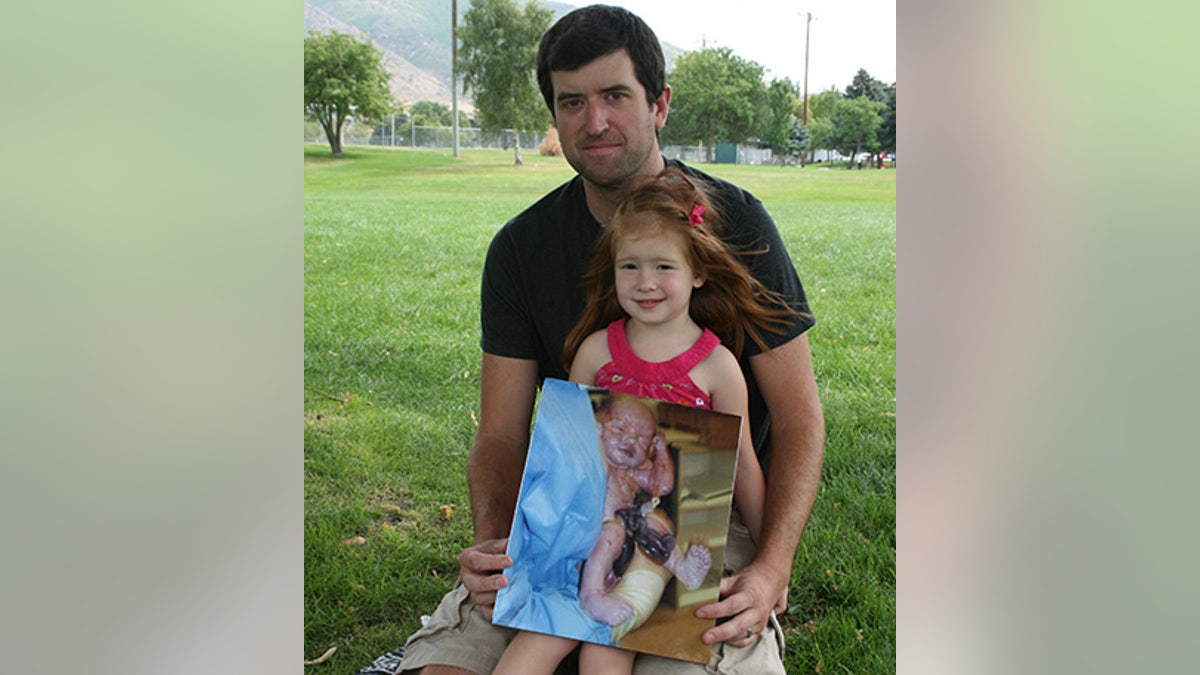
Anna, pictured with her father (neither of whose last names were released), are part of a story series released this week by the Centers for Disease Control and Prevention (CDC). The series details the journeys of patients born with gastroschisis, a serious and potentially life-threatening defect whereby the intestines and sometimes other abdominal organs are born outside of the body. (Photo courtesy the CDC)
Anna, Avery, Genevieve, Ian: Those are a handful of the names of American children with gastroschisis— whereby the intestines are born outside of the body, protruding from a hole beside the belly button— and who are featured in a new story series published by the Centers for Disease Control and Prevention (CDC) this week.
According to an accompanying report released Friday, the CDC estimates the number of gastroschisis cases between 1995 to 2012 has increased— most prevalently among young, non-Hispanic black mothers, who saw a 263 percent increase in cases during that time period. While young maternal age has long been associated with the condition, researchers don’t know the cause of the increase in cases among all the ages and ethnicities they reviewed.
“It concerns us that we don’t know why more babies are being born with this serious birth defect,” Coleen Boyle, Ph.D., director of CDC’s National Center on Birth Defects and Developmental Disabilities, said in a news release. “Public health research is urgently needed to figure out the cause and why certain women are at higher risk of having a baby born with gastroschisis.”
The CDC report, which analyzed data from 14 states, compared the prevalence of babies born with gastroschisis among mothers of every age from 1995 to 2005, to those born between 2006 and 2012. Data from the report suggest that while non-Hispanic white and Hispanic mothers saw an increase in gastroschisis cases, non-Hispanic black mothers who were young saw the greatest increase.
The CDC estimates that about 2,000 American babies are born every year with gastroschisis.
“We must continue to monitor changes in this birth defect to identify risk factors contributing to these increases and hopefully start to reverse the trend,” Peggy Honein, Ph.D., M.P.H., chief, of the Birth Defects Branch at the CDC National Center on Birth Defects and Developmental Disabilities, said in the release.
While doctors can detect whether a child has gastrochisis in utero and those who are born with it often grow up to live relatively healthy lives, the condition can be life-threatening. Gastrochisis can affect other abdominal organs like the stomach and liver, and the condition requires immediate surgery to return the organs inside the infant’s body then to mend the abdominal wall, according to the CDC. After surgery, children usually have to stay in the neonatal intensive care unit (NICU) anywhere from weeks to multiple months at a time. And down the road, children diagnosed with gastroschisis may also have digestive issues, according to the CDC.
In the CDC’s series of seven stories— most of which were written by the mothers of the affected children— one mother, Tiffany, wrote that while her daughter Genevieve is now nearly 3 years old, she continues to struggle with hydration and nutrition due to gastroschisis.
“And, we will always have to watch her for signs of problems,” Tiffany, whose last name wasn’t disclosed, wrote for the CDC. “But, this little girl doesn’t let any of that bother her. She is strong and beautiful and inspiring to those who know her story.”
Brooke, whose last name was also not disclosed, shared a photo of her daughter Anna, past toddlerhood, posing with her father and a photo of her as an infant with her intestines outside of her little body. Anna was also born with gastroschisis.
Brooke tells of how doctors had to whisk Anna away almost immediately after she was delivered for surgery to restore her large intestine and a fallopian tube to her abdomen.
“It was about a week before they attempted giving her my pumped breast milk through a bottle,” Brooke wrote. “She took to it quickly but would soon fall asleep or lose interest. Eventually she was eating a decent amount, and the doctors and nurses were pleasantly surprised with her very rapid progress.”
“After only 17 days in the NICU, our little Anna was released and sent home with us,” Brooke continued. “It was as if a great weight had been lifted off our hearts and shoulders … our little girl was home!”
